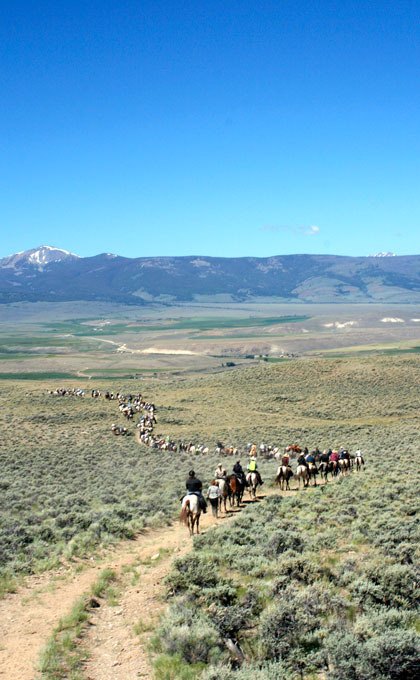After a lifetime of dreaming and 1,300 miles of riding, Oak Harbor resident Kristen Reiter and her Appaloosa horse Raiden made their way onto the Bear Paw Battlefield.
It was the culminating point of the Chief Joseph Trail Ride, a journey of both historical and emotional significance to Reiter, as well as her 167 fellow riders.
Nestled in the heart of the Bears Paw Mountains, the Nez Perce National Historical Park is composed of vast serene and scenic terrain, green and golden hills rolling into the horizon of an expansive blue sky. Much of the park appears untouched, unchanged by the hands of time or mankind.
The quiet beauty of the site belies its tragic history.
IN 1877, after traveling 1,170 miles in flight from the cavalry, the Nez Perce, a Native American tribe also known as Nimiipuu, stopped to rest here at the Bear Paw Battlefield, just 40 miles from freedom, believing the cavalry to be far behind.
When their camp was discovered, the Nimiipuu, starving and cold, fought their final battle before Chief Joseph surrendered, uttering his famous words, “From where the sun now stands, I will fight no more forever.”
The Appaloosa Horse Club founded the trail ride in 1965. Each year since, riders have mounted their Appaloosas to trace the 1,170-mile Nimiipuu flight route.
“So much of the trail ride is history,” Reiter said. “We’re not reliving it by any means, but we’re showing our respect and honoring the people that made that route before us.”

THE TRAIL spans from the James Kipp Recreational Area in Joseph, Ore., to the Nez Perce National Historical Park, just south of Chinook, Montana.
The trail ride is about 1,300 miles, making it a 13-year journey in total, with riders completing 100 miles every summer. Each time they convene at the point where the previous year’s ride had ended and set forth from there.
Reiter aspired to ride the trail since age 12, when she read of it in an equestrian magazine.
Her family had recently purchased their first horse, an Appaloosa, and Reiter had immediately been drawn to the breed and their history as the horses of the Nimiipuu.
Although Reiter is not of Nez Perce descent, she said she’s always been fascinated with the people’s history. She said she values the Nez Perce for their cultivation of the Appaloosa horse she so loves.
“They are the people who created the animal I love so much,” she said, explaining the Nez Perce are credited with breeding Appaloosas to be “strong of mind and heart,” with incredible endurance and strength.
When the cavalry attacked the Nez Perce, many horses were massacred, Reiter said. Others were stolen from their owners and sold.
“That was the wealth of the Nez Perce. You take their wealth away and hold power over them,” she said.
Reiter explained that as important as it was for her to complete the ride, she felt it equally significant for her horse to follow in the steps of his ancestors.
SHE FIRST set forth on the ride abreast her first 4-H horse and has ridden two others since his passing.
After claiming multiple championships in the arena circuit, Reiter found the first leg of the ride to be quite an adjustment, though the challenge was a welcome one. The four walls of the arena couldn’t compare to the vistas of Yellowstone, or the adrenaline of the affectionately-named “Suicide Slide,” she said.
“I don’t know if you could get me back in an arena now.”
“You can see 360 degrees all around you. It’s mountains and valleys, and the geography is stunning,” she said, recalling the view from atop a mountain at Sunlight Basin in Yellowstone. “You just feel like it couldn’t get any better than that.”
From such great heights, the same leg of the ride quickly went downhill with the “Suicide Slide,” which Reiter filmed using her GoPro.

IT WAS here the Nez Perce eluded the cavalry, Reiter explained. All other exits to the canyon had been blocked aside from this particular segment, which was thought to be impassable. It involves a 30-minute precarious ride down the mountain-side by way of switchbacks, the horses sliding on their haunches, pulling forward with their feet.
“You look down the side and it looks like it goes straight down,” she said. “It was a technical ride that day, but it was fun.”
Throughout the ride, several locals and Nimiipuu leaders offered presentations to provide historical and regional context to participants. The final evening included a traditional ceremony by Nimiipuu riders, drummers and dancers, as well as a presentation by Otis Halfmoon, who discussed the events leading up to, during and after Chief Joseph’s surrender.
There was also an empty saddle ceremony, involving a riderless horse led in the procession with two Pendleton blankets tied to its saddle.
ROSA YEAROUT, a Nimiipuu and longtime ride participant, explained that one blanket was presented to Pat Bogar, in honor of her late husband and all Chief Joseph Trail Riders who had passed since the previous ride; the other was presented to Jackie Ingliss, the oldest Nimiipuu on the ride. The blanket was in honor of all those who had died in 1877 along the trail, including Nimiipuu warriors, elderly men, women and children, as well as soldiers and scouts of other tribes.
Reiter and others who had completed the 13th leg of the journey were also recognized.
“It’s super emotional,” Reiter said of the final evening.
Though the 13-year cycle has ended, Reiter’s Chief Joseph journey is far from over. In addition to sponsoring a scholarship program for young people to participate in the ride, Reiter said she plans to embark on the next cycle in 2017.
“It has become part of me; it’s part of my heart,” she said.


